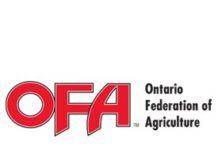by Drew Spoelstra, Vice President, OFA
A sure sign that the end of summer is approaching has always been the opening of the Canadian National Exhibition (CNE) in Toronto. This year’s kick-off at the Exhibition grounds alongside Lakeshore Boulevard is only a few days away – and although it’s in a thoroughly urban location, the CNE is actually one of North America’s top agricultural fairs.
Across Ontario, fall fairs are an important part of the community fabric. In the early days of many communities, the fall fair was the first event they hosted regularly and for many, it’s still one of, if not the biggest community event on the yearly calendar.
The role of the fair is one of both celebration and education. Historically, it was at the fall fairs that farmers brought their best livestock, crops, baking, preserves and other items to enter into competitions as a way to both celebrate the bounty of another season and honour those with excellent production.
And that’s still the case at fall fairs across Ontario. My family and I farm within the city limits of Hamilton near the community of Binbrook, for example, and we’re active participants at our local fair every year, showing horses and taking part in the grain competition.
I’m a strong believer in the ongoing value that fall fairs bring to not just our communities but also to farmers and to Ontarians province wide. That’s what has been a driving force behind my own volunteer involvement with my local fairs in Binbrook and Ancaster for many years.
The agricultural societies that run fall fairs have an official mandate through Ontario’s Agricultural and Horticultural Organizations Act to promote agriculture and agri-food in our province. Many farmers and farm organizations volunteer their time every year to run demonstrations, staff displays and talk about all sorts of agricultural topics from how farm animals are raised to the importance of farm safety.
For agriculture, it’s a valuable outreach tool that can help build public trust in our food supply and for consumers, it’s a great opportunity to meet and speak with real farmers, see farm animals and crops up close, and learn about where food comes from.
That unique ability to bring together farmers and non-farmers also means that many agricultural societies are involved in outreach efforts all year long, not just at fair time. It’s an important role that was recognized by the Ontario Ministry of Agriculture, Food and Rural Affairs recently with the announcement of a three-year program to promote careers in agriculture through agricultural societies.
Through the Promoting Agri-Food Careers Initiative, $1.7 million will be available to Ontario’s 213 agricultural societies for projects and programming that will increase awareness and promote jobs in the agri-food industry.
The chronic labour shortage in agriculture and the high average age of Canadian farmers are well known, so we welcome support like this that will help our sector attract the next generation of workers and leaders.
In addition to education, many agricultural societies also make their grounds available to host other community events or rent facilities to community groups and organizations as a way of generating revenue to help support their operations.
The COVID-19 pandemic cancelled fairs across Ontario for several years and they’re only now just starting to rebound. Throughout the pandemic, the provincial government recognized the challenges those cancellations caused and provided support to help these organizations survive.
So, starting with the CNE over the next couple of weeks and ending with the Royal Agricultural Winter Fair in November, I encourage all of you to take an opportunity to visit a local fair in your area. Check out the displays, speak to exhibitors, taste the food and enjoy the rides and special performances that make up that special fall fair atmosphere. We look forward to seeing you there.


